TORONTO: No Indian star has made a bigger splash in Hollywood than Priyanka Chopra — and the “Baywatch” actress said she is on a quest to shatter myths about Bollywood, including its approach to sex.
Chopra was the first Indian actress to lead a primetime US series with FBI thriller “Quantico,” and cemented her global celebrity status by marrying pop singer Nick Jonas last December.
That star power secured a glitzy, red-carpet slot at Toronto’s film festival for “The Sky is Pink,” Chopra’s first Hindi-language film in three years. It is the only Asian film on the prestigious gala lineup at North America’s biggest movie festival.
“People get surprised when they see ‘The Sky is Pink’ and they’re like, ‘this is not a Bollywood movie.’ Bollywood is not a genre!” Chopra said ahead of the premiere Friday.
“It really is my quest to educate people in that.”
Directed by Shonali Bose, “The Sky is Pink” tells the tragic true story of Aisha Chaudhary, an inspirational Delhi teenager whose life was cut short by a rare genetic disorder.
Chaudhary delivered a TED talk and wrote a book on her battle before her death in 2015 at the age of 18. But the film focuses on her parents, exploring how their marriage and love — and even their sex life — survived the loss of two children.
Until recently kissing was rarely shown in films made by conservative Bollywood, better known abroad for its colorful musical numbers and fairytale romantic plots.
“I don’t think we haven’t spoken about sexuality in Indian films — we do,” said Chopra, 37. “I think sexuality is spoken about in many different ways in Indian cinema.”
“It’s culturally sensitive, yes,” she added. “India is an amalgamation of modernity and tradition. And this film is made by a modern Indian. So hence, you see what her language is. This is true to who she is.”
Bose, whose own marriage ended after she lost her son, was approached by Chaudhary’s parents to make the film.
Chaudhary had been a fervent fan of the director’s work, and never fulfilled her “dying wish” to see Bose’s previous film “Margarita With A Straw.”
Bose said she was moved by the request but chose to focus on the parents after learning of their “amazing” love story and care for their child.
“They wanted the film to be about their heroic dying teenage girl, and I don’t feel she would’ve wanted to be on a pedestal — actually she was really cool and humble,” she said.
Chopra, who does not have children, said she drew on others’ experiences, including Bose’s, to play Chaudhary’s mother Aditi.
But there is plenty of Chopra in the role too. At one point her character is described as “the ‘almost’ Miss India.” Chopra herself was crowned Miss World in 2000.
As beauty pageants led to acting, Chopra, who attended school in the US, said she held onto her global outlook.
Also a singer, Chopra has released songs with US chart-toppers including Pitbull and The Chainsmokers.
“It’s a genuine quest of mine to be able to cross-pollinate cultures, and to be able to take Indian cinema to the globe as much as I can,” she said, adding: “It’s not the language that’s the barrier — it is the fear of the unknown.”
Movie-mad India has the largest film industry in the world in terms of the number produced — up to 2,000 every year in more than 20 languages, according to industry data.
Bollywood star Akshay Kumar regularly appears in Forbes’ annual list of the world’s top 10 highest-paid actors.
In recent years Bollywood’s influence has spread in North America, thanks to a growing, affluent South Asian diaspora — and a smattering of Western converts.
But while other Bollywood actors and actresses have landed high-profile roles in the US, such as Deepika Padukone in 2017’s “XXX: Return of Xander Cage,” none are as recognizable as Chopra.
“I really hope that there’s so many more entertainers from India that get the opportunity and push themselves toward global entertainment,” said Chopra.
“The world of entertainment is so global now,” she added. “With streaming coming in everyone from anywhere can watch anything.”
‘My quest’: Priyanka Chopra brings Bollywood to Toronto
‘My quest’: Priyanka Chopra brings Bollywood to Toronto

- Priyanka Chopra was the first Indian actress to lead a primetime US series
- ‘The Sky is Pink is Chopra’s first Hindi-language film in three year
Morad Mostafa’s Red Sea-backed debut feature ‘Aisha Can’t Fly Away’ heads to Cannes

DUBAI: The Cannes Film Festival has revealed its official selection for 2025, with “Aisha Can’t Fly Away” by Egyptian filmmaker Morad Mostafa featured in the prestigious Un Certain Regard section.
Developed with the support of the Red Sea Film Foundation through its Red Sea Labs program, the film tells the story of Aisha, a 26-year-old Somali woman living in Ain-Shams — a Cairo neighborhood home to a large African migrant community.
As the authorities turn a blind eye to escalating violence and rising tensions between locals and migrants, control of the area falls into the hands of various gangs. When one gang offers Aisha protection in exchange for a personal favor, her life begins to unravel.
Mostafa shared the news on Instagram, saying: “Extremely proud to announce that my first feature film ‘Aisha Can’t Fly Away’ in the Official Selection of the 78th Festival de Cannes in the prestigious section Un Certain Regard.”
He added that this marks the “first Egyptian film in nine years to be selected for Un Certain Regard.”
The movie stars Buliana Simon, Ziad Zaza and Emad Ghoniem.
‘At The Edge’: Sharp curatorial vision shines in flagship show at first Art Week Riyadh

RIYADH: As the inaugural Art Week Riyadh unfolds across the city, it signals more than just a new entry on the cultural calendar — it marks a shift in how contemporary art is being framed, experienced, and contextualized in the Kingdom. Running until Apr. 13, the weeklong event resists the format of the conventional art fair, instead offering an expansive experience that speaks to Saudi Arabia’s evolving cultural identity.
The flagship exhibition of the event, “At The Edge,” brings together over 30 galleries from Saudi Arabia and beyond. Their curated presentations do not merely showcase work — they provoke dialogue, challenge assumptions, and reflect the complex, often contrasting, cultural currents that define both the local and global contemporary art landscapes.

The full art exhibition, organized by the Visual Arts Commission, has been curated by Vittoria Matarrese, along with associate curators Basma Harasani and Victoria Gandit-Lelandais.
Upon entering the dedicated space at JAX district in Diriyah, one of the first major pieces you will encounter is “Le grand miroir du monde” (2017) by French-Algerian artist Kader Attia. Presented in collaboration with Galleria Continua, it marks Attia’s first time exhibiting the work in the Kingdom.
Attia, whose multidisciplinary practice spans installation, sculpture, photography and video, draws on his dual heritage to explore the lasting impact of colonialism. His work confronts historical and contemporary trauma by examining cultural identity, collective memory and the process of repair — both physical and symbolic.
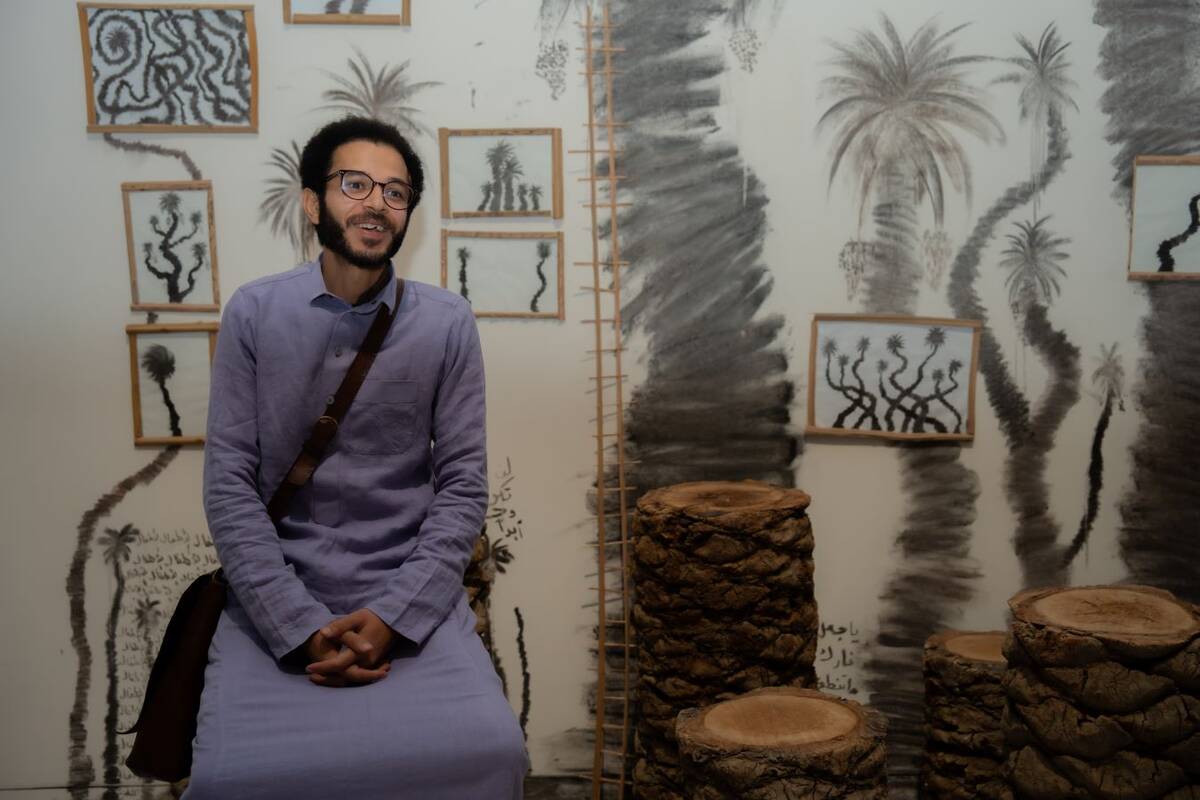
The site-specific installation features fragmented mirrors, layered atop each other, forming a grand, almost puddle-like surface of shards. It reflects the ceiling, the light — and even the viewer. Meant to be seen from a slightly elevated vantage point, the work occupies a large space, reminiscent of a shattered ice-skating rink, gliding — and guiding — visitors into the rest of the exhibition.
This leads into an organic labyrinth of treasures, each work nestled in a contained place yet arranged to be in dialogue with its neighbors. Artists, works, moods, materials and voices from across generations and more than 25 countries interact.
Joud Fahmy’s “Trapped Emotions: Nostalgia” (2025) — a tactile piece made of dyed wool and rope intertwined with metal — strikes a powerful emotional chord. Fahmy, a Saudi artist represented by Hunna Art, often explores gender, family and cultural identity through mixed media and audiovisual installations.
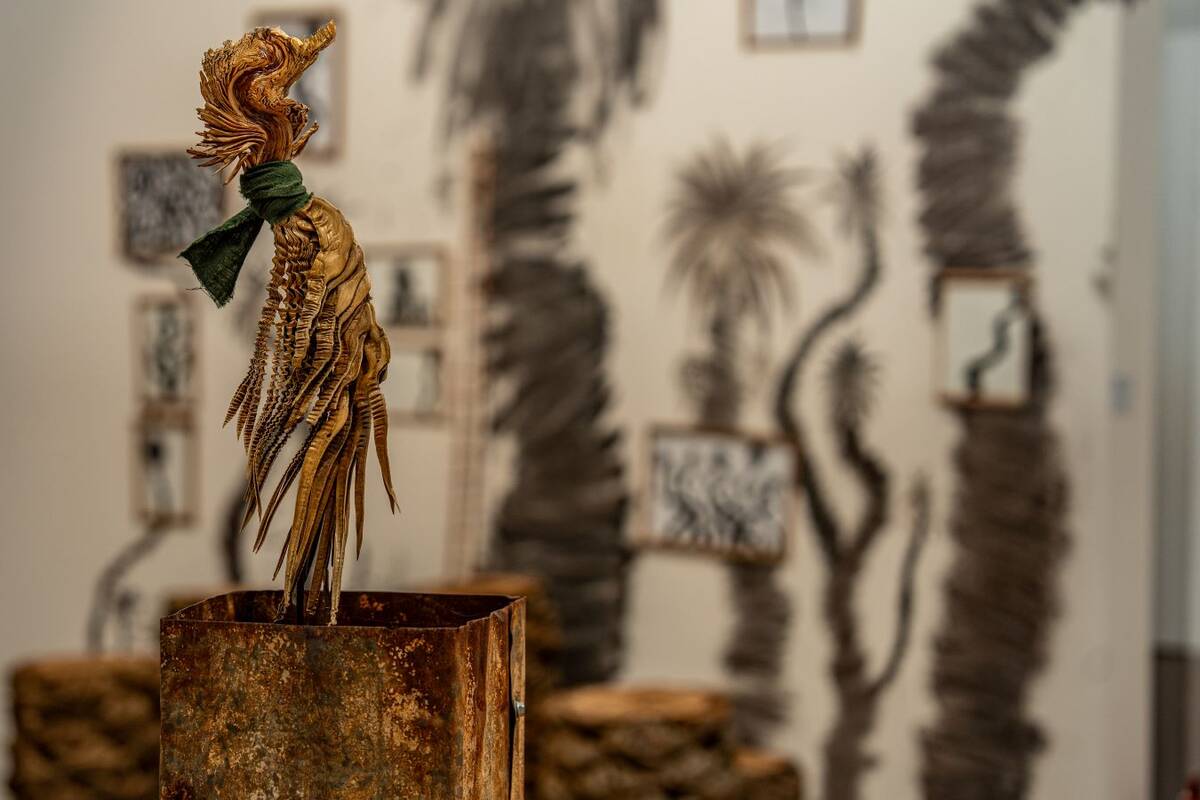
Another notable work is “Dream Coat” (2024) by Greek artist Nefeli Papadimouli, composed of cotton garments and a wooden structure. Based in Paris, Papadimouli blends sculpture, drawing, performance and participatory action. Often working with fabric and soft materials, her architectural, abstract forms echo the visual language of the late Etel Adnan. Her work reflects on how we move through and shape shared environments, investigating belonging, intimacy and collective memory.
Riyadh-based artist Maisa Sheldan, who also maintains a studio at JAX, presents a standout installation. A Saudi artist of Palestinian origin, Sheldan explores human issues and collective memory by reconstructing raw materials into symbolic forms that reflect the impact of time. Her work, represented by Hafez Gallery, blends authenticity with contrasts between the visible and the invisible. The seemingly feathered cocoon chair invites you to immerse yourself in the space and swing along. The army of animals, all made from organic materials, is a striking image and one of my favorite works on display. It is playful and tells a story.
Representing Al-Ahsa, Mohammad Alfaraj is exhibiting with Mennour Gallery. As always, the use of palms is central to his work. A son and grandson of date farmers, Alfaraj grew up in the world’s largest desert oasis. Though he studied applied mechanical engineering at university, he describes himself as “a poet of visuals.” His upbringing on a farm instilled in him a deep commitment to reuse all materials and to prioritize sustainability.
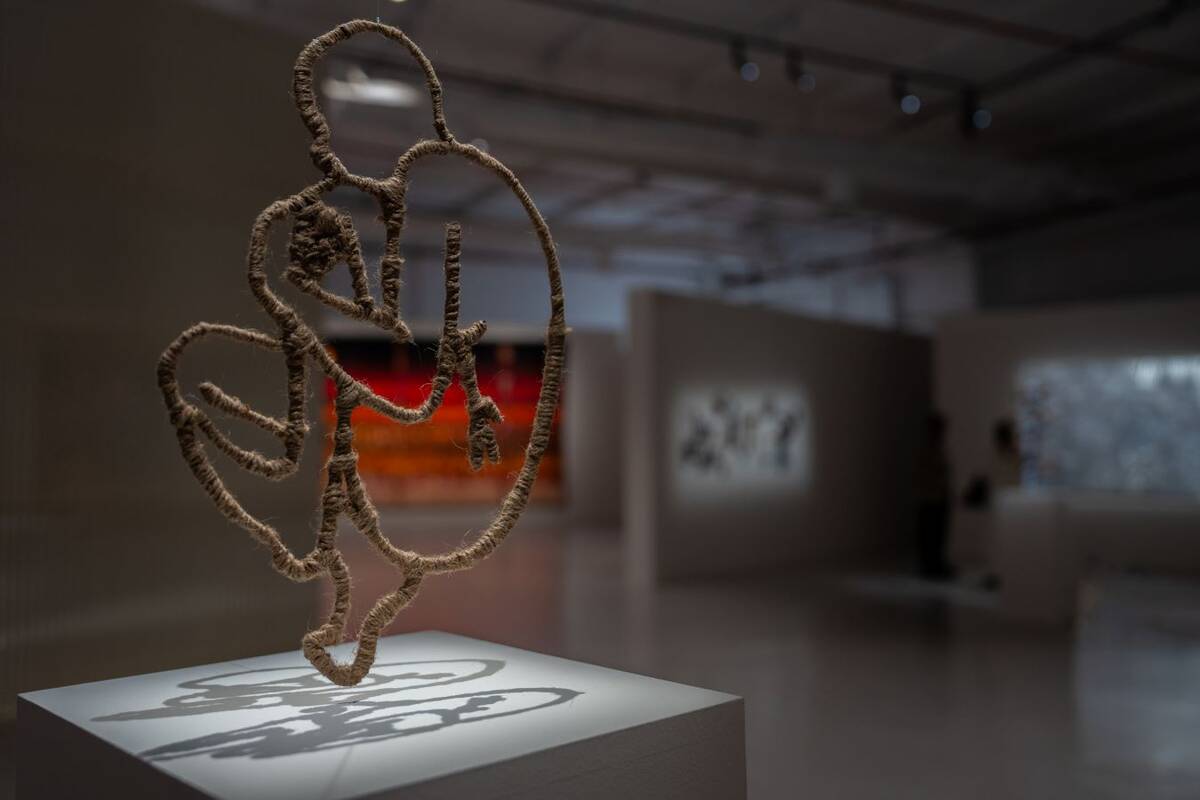
Nestled within a smaller area is “From Earth: Historic Diriyah Materials Lab,” presented by the Diriyah Gate Development Authority. A small but powerful space invites viewers to explore the raw materials that shaped Diriyah: mud, limestone, palm fronds, wool and pigments. These natural elements, drawn from the land, speak to centuries of resilience, adaptation and environmental knowledge. The exhibition forces one to separate the materials and highlights them, both in their pure state and their crafted forms: mud transformed into bricks, palm fronds woven into objects, plants used to create vibrant pigments. Far from being relics, these materials remain living resources that breathe life into the works that they are used for.
“I’m absolutely thrilled to be able to be a part of an initiative that really is creating a platform that will give voice to practitioners from Saudi Arabia,” Dina Amin, CEO of VAC, told Arab News regarding the activations.
“Art Week Riyadh is creating a wonderful moment for the people of Saudi Arabia to really be able to engage in many ways through the exhibitions: through the different locations, through the talks, through the workshops, through the open studios,” she added.
Amin also shared a personal experience: “The other day, I was walking around and popping into the studios, and it’s just absolutely wonderful to see the variety of language that each of the artists uses in his or her own work.
“For us, Art Week Riyadh is really about creating a moment of gravitational pull where we can bring all of the different practitioners together. What we really are celebrating here is everybody’s voice. We want to share our creativity, our culture, our engagement with art with the world, but we also want to invite everyone to come and discover it.”
REVIEW: Kuwaiti Palestinian author looks at women and disability in a transformative, speculative memoir

JEDDAH: Kuwaiti Palestinian writer Shahd Alshammari’s new speculative memoir “Confetti and Ashes” is a bold departure from her previous work “Head Above Water,” which was longlisted for the Barbellion Prize in 2022.
Alshammari’s layered meditation on the disabled body as both a site of loss as well as endurance is propelled forward by sharp observations and a quiet brilliance that had me turning pages well into the night.
Her first memoir, “Head Above Water,” offered an unflinching look at navigating multiple sclerosis as an Arab woman teaching literature in Kuwait. Her latest, however, ventures into a realm where memory and personal narrative intersect with poetry, imagination, and otherworldly presences.
The voices of ghosts and Zari, her qareen — the jinn-companion assigned to each person in Islamic belief — transform Alshammari’s personal narrative. It becomes a dialogue, a captivating dance between the seen and unseen worlds.
This inclusion shakes up the conventional memoir structure to broaden the scope beyond Western frameworks of storytelling. It also offers readers a visceral look at the ways living with disability and chronic illness can disrupt and reshape an individual’s perspective and worldview.
The dreamlike and omniscient voice of the qareen also mirrors the disorientation and internal struggles that come with living with chronic illness and disability.
Alshammari astutely draws parallels between the disabled body and the female body in the social and cultural context of Kuwait. In a world of able-bodied norms, she reflects on their intersecting experiences of marginalization, scrutiny, and resistance.
She rejects predictable storytelling, and not just in her writing, but also in life. Her body rebels, yet she defies societal stigmas — including concerns voiced from other women with MS.
She explores holistic wellness practices and eventually takes up squash, expanding her social circle and pushing her limits to build her mental and physical endurance.
In capturing her dual journeys of illness and wellness, the author invites readers to reflect on the disabled body not as a burden, but as a site of poetic possibility.
In “Confetti and Ashes,” Alshammari presents a profound reclamation of the self and cements herself as a vital voice in reimagining the female disabled experience.
Art Week Riyadh: 3 generations of Saudi abstract art on display

- The Saudi Research and Media Group unveiled a compelling collection at the inaugural art festival
RIYADH: The Saudi Research and Media Group unveiled a compelling collection at the inaugural Art Week Riyadh that traces the evolution of Saudi abstraction.
Titled “Abstract Horizons,” it highlights the pioneering contributions of artists like Mohammed Al-Saleem and Abdulhalim Radwi, whose work helped lay the groundwork for the Kingdom’s contemporary art movement.
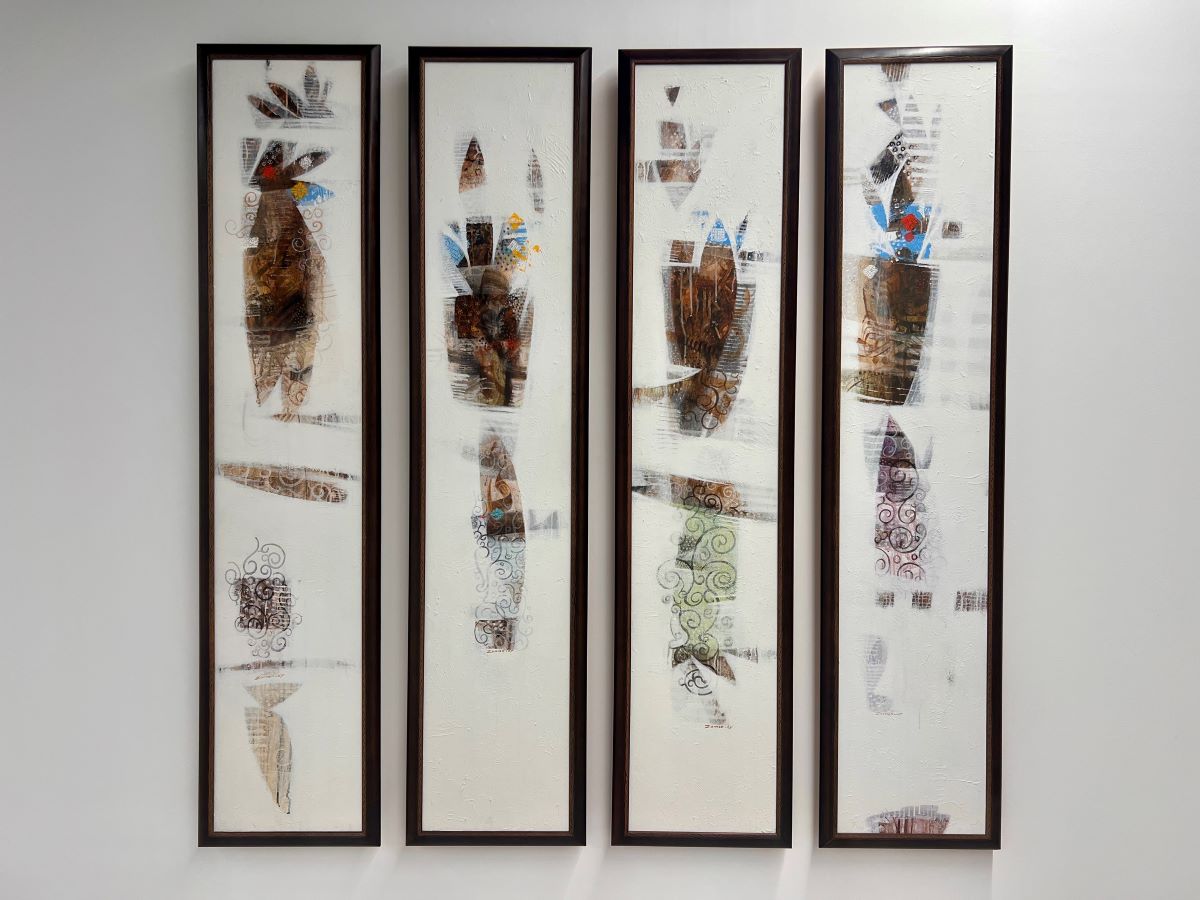
Borrowing its name from Al-Saleem’s seminal work, the collection takes a unique approach, emphasizing the shifting aesthetic and intellectual currents of the Kingdom through the abstract practices of three generations of Saudi artists.
The exhibition seamlessly flows from the early beginnings with artists born in the 1930s and 1940s, whose work predominantly emerged in the 1990s: Radwi was a foundational figure in Saudi modernism; Al-Saleem, who became notable for establishing the “horizonism” movement, characterized his work with a geometric depiction of the Saudi skyline and desertscape; Taha Al-Seban furthered the desert motif with his unique color compositions.
From there, it can be seen how abstraction has transformed into a crucial language in the cultural scene.
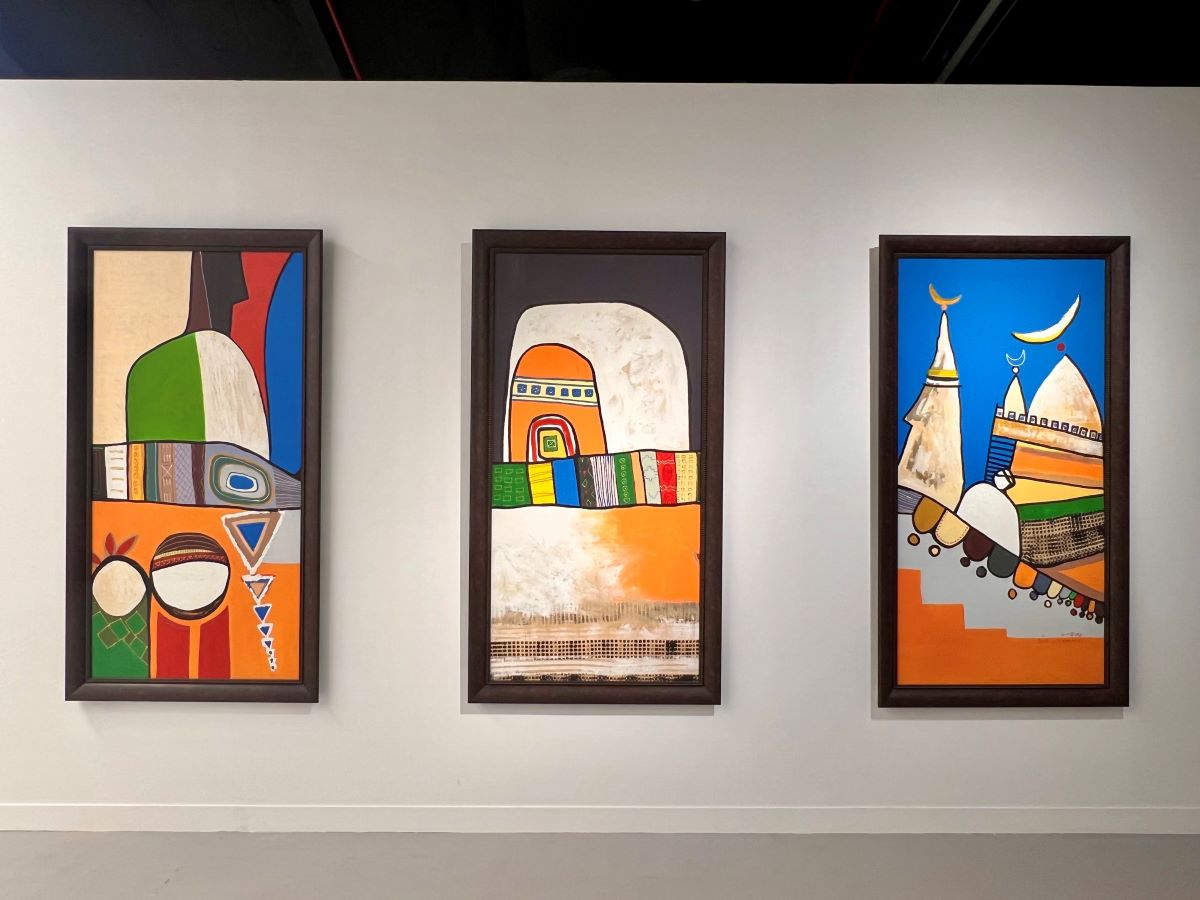
The exhibition continues to work from the early 2000s, engaging more with culture, identity and memory. There are artists like Abdulrahman Al-Soliman, also a critic, who infused architectural elements to bridge between heritage and contemporary expression; Abdullah Hamas, who reimagines the Saudi landscape through geometric compositions; Fahad Al-Hajailan, whose abstraction plays with color and movement; Raeda Ashour, one of the first female Saudi abstract artists, who adopts a minimalist yet evocative approach with a chromatic palette and fluid silhouettes.
Then, at the turn of the 21st century, there is the work of artists born in the 1970s. Abstraction is now a conceptual tool.
Rashed Al-Shashai, known for his experimental approach, repurposes everyday materials to construct layered compositions that address the tension between tradition and modernity while, in contrast, Zaman Jassim’s abstraction interplays between the tangible and the elusive.
SRMG’s collection is on display as part of an exhibition titled “Collections in Dialogue,” featuring collected works by the King Abdulaziz Center for World Culture (Ithra) and Hayy Jameel.
Art Week Riyadh: Coollect on a mission to ‘make art collecting cool again’

RIYADH: Art Week Riyadh, running until April 13, aims to spark a passion for collecting art in the heart of the capital. The event carries the tagline “a local art-collecting experience — anonymous displays, pure discovery.”
At the center of the initiative is Coollect, a pop-up exhibition curated by Jeddah-based Sara Alourfi, whose background spans a bachelor’s degree in visual arts from Switzerland and a master’s in curatorial management from Italy. Known for her sharp curatorial sensibility across contemporary art and fashion, Alourfi brings together a standout selection of emerging and established talent for this Art Week Riyadh
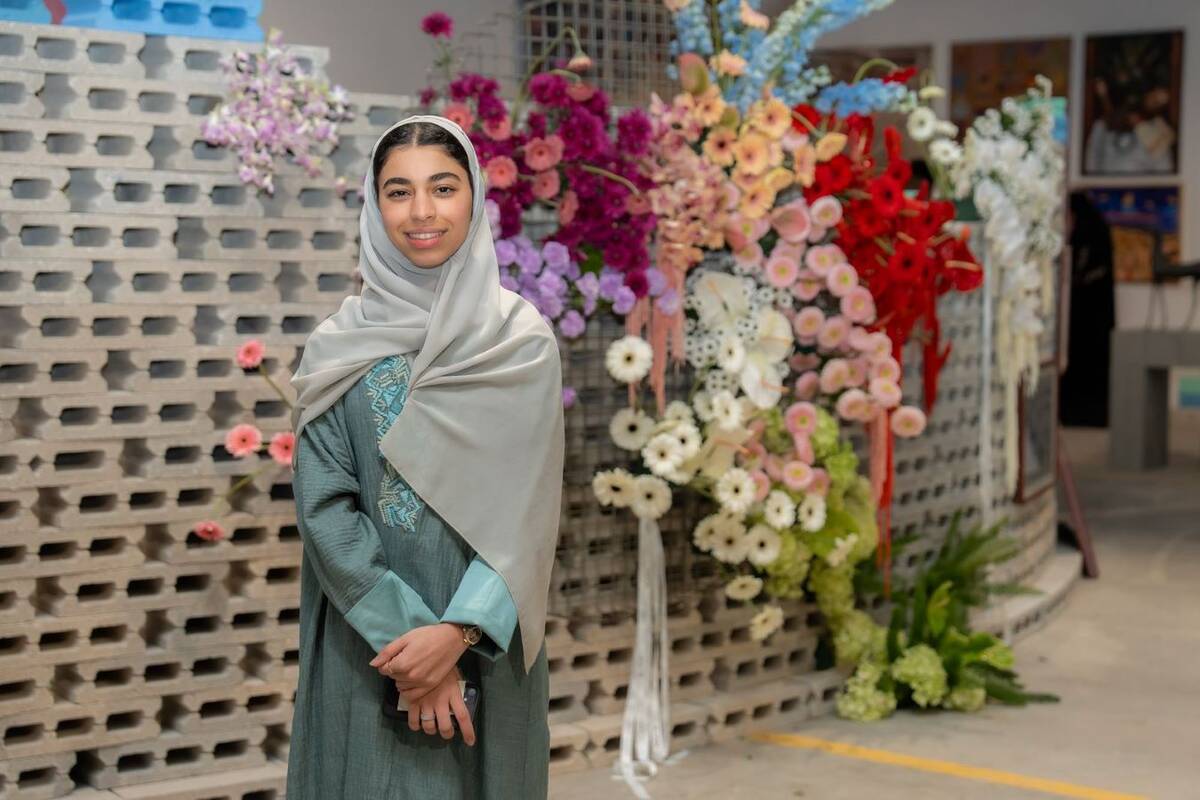
The initiative is produced by atrum, an art consultancy dedicated to both curating exhibitions and supporting artists through its dynamic online platform.
“This is an activation by a company called atrum — an art company that offers art consultancy. They create exhibitions and support local artists with an online platform,” Alourfi told Arab News.
“Coollect is about making collecting cool again,” she told Arab News. “It’s about introducing the idea of collecting to the younger generation in Saudi. We wanted to break the fear of collecting … so we asked artists to submit artworks without any signatures and with different styles than they usually create.”
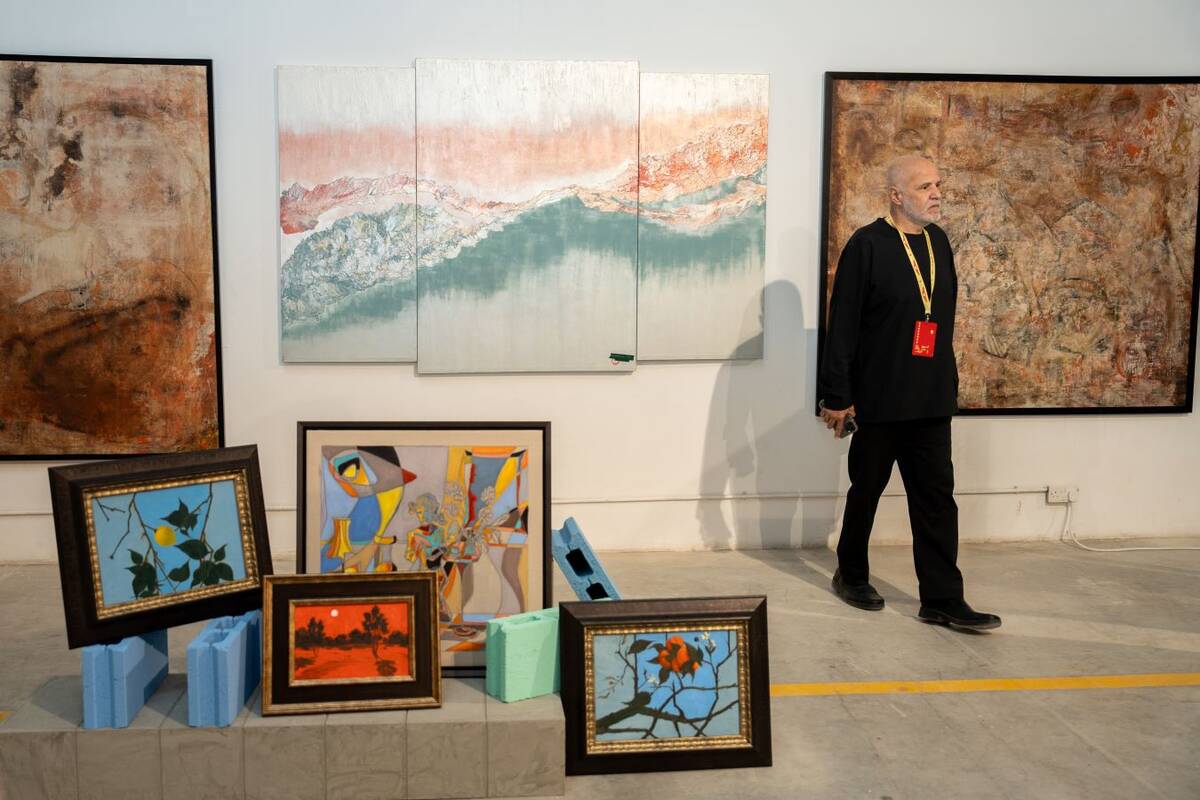
The artworks — anonymous and untitled — encourage viewers to engage without preconceived notions. All the participating artists contributed using mediums that differ from their usual work. Artists were also encouraged to use local framers and printers, reinforcing the emphasis on supporting the local ecosystem.
More than 120 artists have participated in the initiative. Some created new pieces specifically for the show, while others submitted works that challenge or expand their typical practice. “It’s a mix between emerging and established artists, and a mix between local, regional and international,” Alourfi told Arab News. “The youngest artist we have is actually 13 years old — but you wouldn’t know. You’d be surprised.”
Sales begin on April 12 and end on April 13. Prices, ranging from $133 to $2,130, will be revealed on-site, and buyers will only discover the identity of the artist after purchase. The price point is not indicative of the artist who made the work.
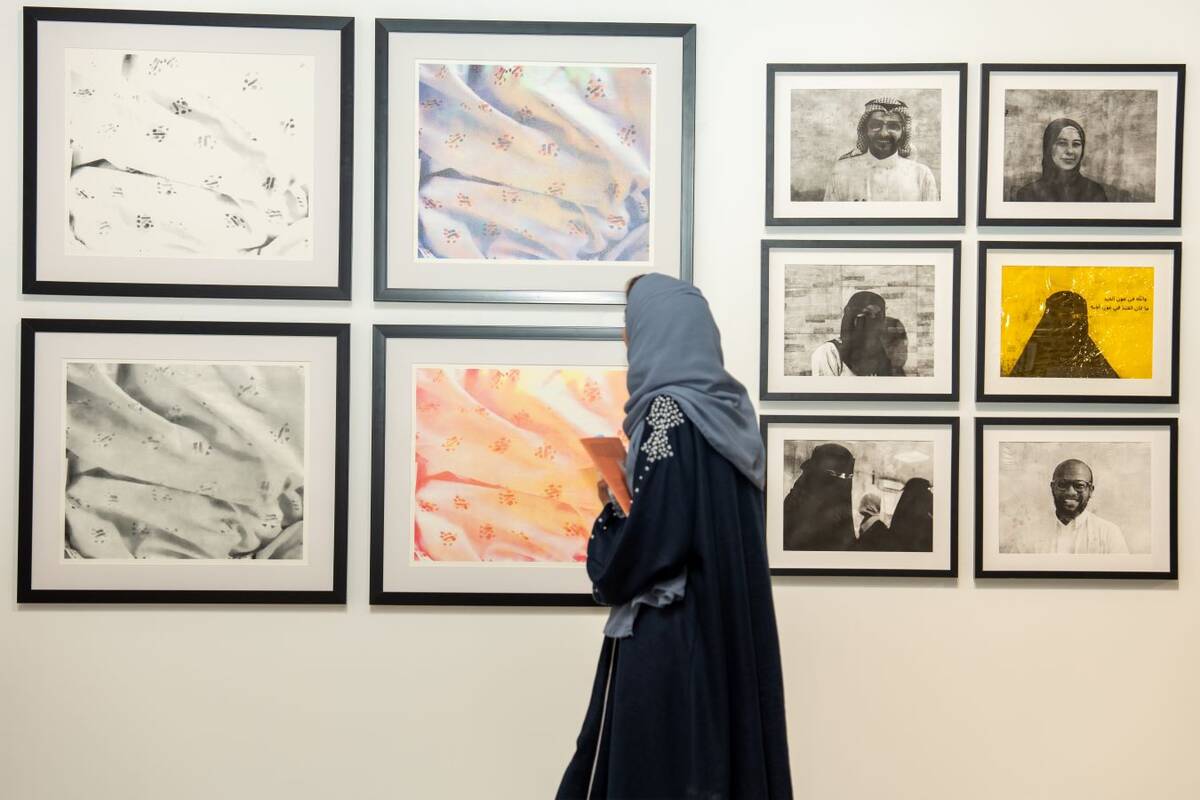
(AN Photo by Huda Bashatah)
The concept began nearly a year ago, with a focused artist selection process starting during Ramadan. Atrum promoted the initiative through WASM Studio and social media, resulting in a dynamic pool of talent.
“At atrum, we aim to break boundaries and think beyond the conventional — striving to constantly create new concepts to support the art ecosystem and give back to Saudi Arabia’s vibrant and ever-growing creative community,” Princess Sara Sultan Fahad Al-Saud, co-founder of atrum, told Arab News.
Alongside her and co-founder Nayfa Rayed Al-Brahim, the team of organizers also included Saudi artist Ziyad Alrogi.
On opening night, spectators wandered in and tried to guess who might have created which piece. Many established artists were seen viewing the works but they could not confirm nor deny whether their works were even included. It created an immersive and interactive setting.
“It’s truly heartwarming to see so many from our creative community come together to support and help bring this concept to life — not because they stood to gain anything, but simply because they believed in it,” Al-Brahim told Arab News. “Their willingness to be part of something bigger speaks volumes about the spirit of our community.”
Coollect is open now at JAX, where visitors can experience and explore the works before the sale opens to the public as the AWR finale.










